Toward the Circular Economy in the Aquaculture Sector: Bibliometric, Network and Content Analyses
Abstract
:1. Introduction
2. Methodology
2.1. Data Collection
2.2. Systematic Review: Bibliometric, Network and Content Analyses
- Micro level—circularity tactics directly affect animal metabolism;
- Meso level—the proposed CSs concern energy and material exchanges between the aquaculture system and the environment;
- Macro level—concerns the possibility of the market, society and policies to favor the diffusion of circular practices for the sector.
- Studies that analyze “closed-loop” circularity strategies;
- Studies that analyze “open-loop” circularity strategies.
3. Results
3.1. Bibliometric Analysis
3.2. Network Analysis
3.3. Content Analysis
4. Conclusions
Author Contributions
Funding
Institutional Review Board Statement
Informed Consent Statement
Data Availability Statement
Acknowledgments
Conflicts of Interest
References
- FAO. The State of World Fisheries and Aquaculture (2020); FAO Fisheries and Aquaculture Department: Rome, Italy, 2020. [Google Scholar]
- Ruiz-Salmón, I.; Margallo, M.; Laso, J.; Villanueva-Rey, P.; Mariño, D.; Quinteiro, P.; Dias, A.C.; Nunes, M.L.; Marques, A.; Feijoo, G.; et al. Addressing challenges and opportunities of the European seafood sector under a circular economy framework. Curr. Opin. Environ. Sci. Health 2020, 13, 101–106. [Google Scholar] [CrossRef]
- European Commission. Report from the Commission to the European Parliament, the Council, the European Economic and Social Committee and the Committee of the Regions on the Implementation of the Circular Economy Action Plan. 2019. Available online: https://op.europa.eu/en/publication-detail/-/publication/ade8c7de-3e8f-11e9-8d04-01aa75ed71a1/language-en (accessed on 15 February 2023).
- Puszkarski, J.; Śniadach, O. Instruments to implement sustainable aquaculture in the European Union. Mar. Policy 2022, 144, 105215. [Google Scholar] [CrossRef]
- MacArthur, E. Towards the circular economy. J. Ind. Ecol. 2013, 2, 23–44. [Google Scholar]
- Regueiro, L.; Newton, R.; Soula, M.; Méndez, D.; Kok, B.; Little, D.C.; Pastres, R.; Johansen, J.; Ferreira, M. Opportunities and limitations for the introduction of circular economy principles in EU aquaculture based on the regulatory framework. J. Ind. Ecol. 2022, 26, 2033–2044. [Google Scholar] [CrossRef]
- Das, S.K.; Mondal, B.; Sarkar, U.K.; Das, B.K.; Borah, S. Understanding and approaches towards circular bio-economy of wastewater reuse in fisheries and aquaculture in India: An overview. Rev. Aquac. 2023, 15, 1100–1114. [Google Scholar] [CrossRef]
- Pounds, A.; Kaminski, A.M.; Budhathoki, M.; Gudbrandsen, O.; Kok, B.; Horn, S.; Malcorps, W.; Mamun, A.; McGoohan, A.; Newton, R.; et al. More than fish—Framing aquatic animals within sustainable food systems. Foods 2022, 11, 1413. [Google Scholar] [CrossRef] [PubMed]
- Troell, M.; Costa-Pierce, B.; Stead, S.; Cottrell, R.S.; Brugere, C.; Farmery, A.K.; Little, D.C.; Strand, Å.; Pullin, R.; Soto, D.; et al. Perspectives on aquaculture’s contribution to the Sustainable Development Goals for improved human and planetary health. J. World Aquac. Soc. 2023, 54, 251–342. [Google Scholar] [CrossRef]
- Raffray, M.; Martin, J.C.; Jacob, C. Socioeconomic impacts of seafood sectors in the European Union through a multi-regional input output model. Sci. Total Environ. 2022, 850, 157989. [Google Scholar] [CrossRef] [PubMed]
- Jacob, C.; Noirot, C.; Anglada, C.; Binet, T. The benefits of integrating socioeconomic dimensions of circular economy practices in the seafood sector. Curr. Opin. Environ. Sci. Health 2021, 22, 100255. [Google Scholar] [CrossRef]
- Newton, R.W.; Little, D.C. Mapping the impacts of farmed Scottish salmon from a life cycle perspective. Int. J. Life Cycle Assess. 2018, 23, 1018–1029. [Google Scholar] [CrossRef]
- Chary, K.; van Riel, A.J.; Muscat, A.; Wilfart, A.; Harchaoui, S.; Verdegem, M.; Filgueira, R.; Troell, M.; Henriksson, P.J.; de Boer, I.J.; et al. Transforming sustainable aquaculture by applying circularity principles. Rev. Aquac. 2024, 16, 656–673. [Google Scholar] [CrossRef]
- Masi, M.; La Sala, P.; Coluccia, B.; Adinolfi, F.; Vecchio, Y. Circular economy in aquaculture: The perspectives of aspiring future operators. Br. Food J. 2024, 126, 489–505. [Google Scholar] [CrossRef]
- De Rosa, M.; Di Pasquale, J.; Adinolfi, F. The Root towards More Circularized Animal Production Systems: From Animal to Territorial Metabolism. Animals 2021, 11, 1540. [Google Scholar] [CrossRef] [PubMed]
- Agnusdei, G.P.; Coluccia, B. Sustainable agrifood supply chains: Bibliometric, network and content analyses. Sci. Total Environ. 2022, 824, 153704. [Google Scholar] [CrossRef] [PubMed]
- Agnusdei, G.P.; Elia, V.; Gnoni, M.G. Is digital twin technology supporting safety management? A bibliometric and systematic review. Appl. Sci. 2021, 11, 2767. [Google Scholar] [CrossRef]
- Lozano, S.; Calzada-Infante, L.; Adenso-Díaz, B.; García, S. Complex network analysis of keywords co-occurrence in the recent efficiency analysis literature. Scientometrics 2019, 120, 609–629. [Google Scholar] [CrossRef]
- Baminiwatta, A.; Solangaarachchi, I. Trends and developments in mindfulness research over 55 years: A bibliometric analysis of publications indexed in web of science. Mindfulness 2021, 12, 2099–2116. [Google Scholar] [CrossRef]
- van Eck, N.J.V.; Waltman, L. How to normalize cooccurrence data? An analysis of some well-known similarity measures. J. Am. Soc. Inf. Sci. Technol. 2009, 60, 1635–1651. [Google Scholar]
- Beske-Janssen, P. Circular economy. In The Supply Chain: A System in Crisis; Edward Elgar Publishing: Cheltenham, UK, 2024; pp. 134–151. [Google Scholar]
- Berbel, J.; Posadillo, A. Review and analysis of alternatives for the valorisation of agro-industrial olive oil by-products. Sustainability 2018, 10, 237. [Google Scholar] [CrossRef]
- Asveld, L.; Van Est, R.; Stemerding, D. (Eds.) Getting to the Core of the Bio-Economy. A Perspective on the Sustainable Promise of Biomass; Rathenau Instituut: The Hague, The Netherlands, 2011. [Google Scholar]
- Sicilia, M.A.; Sánchez-Alonso, S.; García-Barriocanal, E. Comparing impact factors from two different citation databases: The case of computer science. J. Informetr. 2011, 5, 698–704. [Google Scholar] [CrossRef]
- Susarla, S.M.; Rada, E.M.; Lopez, J.; Swanson, E.W.; Miller, D.; Redett, R.J.; Kumar, A.R. Does the H index correlate with academic rank among full-time academic craniofacial surgeons? J. Surg. Educ. 2017, 74, 222–227. [Google Scholar] [CrossRef] [PubMed]
- McDonough, W.; Braungart, M. Cradle to Cradle: Remaking the Way We Make Things; North Point Press: Berkeley, CA, USA, 2010. [Google Scholar]
- Campos, I.; Valente LM, P.; Matos, E.; Marques, P.; Freire, F. Life-cycle assessment of animal feed ingredients: Poultry fat, poultry by-product meal and hydrolyzed feather meal. J. Clean. Prod. 2020, 252, 119845. [Google Scholar] [CrossRef]
- Parolini, M.; Ganzaroli, A.; Bacenetti, J. Earthworm as an alternative protein source in poultry and fish farming: Current applications and future perspectives. Sci. Total Environ. 2020, 734, 139460. [Google Scholar] [CrossRef] [PubMed]
- Malcorps, W.; Newton, R.W.; Sprague, M.; Glencross, B.D.; Little, D.C. Nutritional characterisation of European aquaculture processing by-products to facilitate strategic utilisation. Front. Sustain. Food Syst. 2021, 5, 720595. [Google Scholar] [CrossRef]
- Ahmad, A.; Hassan, S.W.; Banat, F. An overview of microalgae biomass as a sustainable aquaculture feed ingredient: Food security and circular economy. Bioengineered 2022, 13, 9521–9547. [Google Scholar] [CrossRef] [PubMed]
- d’Orbcastel, E.R.; Lutier, M.; Le Floc’h, E.; Ruelle, F.; Triplet, S.; Le Gall, P.; Hubert, C.; Fortune, M.; Laugier, T.; Geoffroy, T.; et al. Marine ecological aquaculture: A successful Mediterranean integrated multi-trophic aquaculture case study of a fish, oyster and algae assemblage. Aquac. Int. 2022, 30, 3143–3157. [Google Scholar] [CrossRef]
- Chen, J.H.; Kato, Y.; Matsuda, M.; Chen, C.Y.; Nagarajan, D.; Hasunuma, T.; Kondo, A.; Dong, C.; Lee, D.; Chang, J.S. A novel process for the mixotrophic production of lutein with Chlorella sorokiniana MB-1-M12 using aquaculture wastewater. Bioresour. Technol. 2019, 290, 121786. [Google Scholar] [CrossRef] [PubMed]
- Stiles, W.A.; Styles, D.; Chapman, S.P.; Esteves, S.; Bywater, A.; Melville, L.; Silkina, A.; Lupatsch, I.; Grünewald, C.F.; Lovit, R.; et al. Using microalgae in the circular economy to valorise anaerobic digestate: Challenges and opportunities. Bioresour. Technol. 2018, 267, 732–774. [Google Scholar] [CrossRef] [PubMed]
- Custódio, M.; Villasante, S.; Cremades, J.; Calado, R.; Lillebø, A.I. Unravelling the potential of halophytes for marine integrated multi-trophic aquaculture (IMTA) a perspective on performance, opportunities and challenges. Aquac. Environ. Interact. 2017, 9, 445–460. [Google Scholar] [CrossRef]
- Napolitano, G.; Venditti, P.; Agnisola, C.; Quartucci, S.; Fasciolo, G.; Tomajoli MT, M.; Geremia, E.; Catone, C.M.; Ulgiati, S. Towards sustainable aquaculture systems: Biological and environmental impact of replacing fishmeal with Arthrospira platensis (Nordstedt) (spirulina). J. Clean. Prod. 2022, 374, 133978. [Google Scholar] [CrossRef]
- Mardones, A.; Cabrera-Barjas, G.; Salas, X. Circular Economy for Fish Farms in Araucanía, Chile. IOP Conf. Ser. Earth Environ. Sci. 2020, 503, 012015. [Google Scholar] [CrossRef]
- Monteiro dos Santos, D.K.; Santana, T.M.; de Matos Dantas, F.; Farias, A.B.D.S.; Epifânio, C.M.F.; Prestes, A.G.; da Fonseca, F.A.L.; Parisi, G.; Viegas, E.M.M.; Gonçalves, L.U. Defatted black soldier fly larvae meal as a dietary ingredient for tambaqui (Colossoma macropomum): Digestibility, growth performance, haematological parameters, and carcass composition. Aquac. Res. 2022, 53, 6762–6770. [Google Scholar] [CrossRef]
- Hoerterer, C.; Petereit, J.; Lannig, G.; Johansen, J.; Pereira, G.V.; Conceição, L.E.; Pastres, R.; Buck, B.H. Sustainable fish feeds: Potential of emerging protein sources in diets for juvenile turbot (Scophthalmus maximus) in RAS. Aquac. Int. 2022, 30, 1481–1504. [Google Scholar] [CrossRef]
- Owsianiak, M.; Pusateri, V.; Zamalloa, C.; de Gussem, E.; Verstraete, W.; Ryberg, M.; Valverde-Pérez, B. Performance of second-generation microbial protein used as aquaculture feed in relation to planetary boundaries. Resour. Conserv. Recycl. 2022, 180, 106158. [Google Scholar] [CrossRef]
- Morris, J.P.; Backeljau, T.; Chapelle, G. Shells from aquaculture: A valuable biomaterial, not a nuisance waste product. Rev. Aquac. 2019, 11, 42–57. [Google Scholar] [CrossRef]
- Vishwakarma, R.; Dhaka, V.; Ariyadasa, T.U.; Malik, A. Exploring algal technologies for a circular bio-based economy in rural sector. J. Clean. Prod. 2022, 354, 131653. [Google Scholar] [CrossRef]
- Thomas JB, E.; Sinha, R.; Strand, Å.; Söderqvist, T.; Stadmark, J.; Franzén, F.; Ingmansson, I.; Gröndahl, F.; Hasselström, L. Marine biomass for a circular blue-green bioeconomy? A life cycle perspective on closing nitrogen and phosphorus land-marine loops. J. Ind. Ecol. 2022, 26, 2136–2153. [Google Scholar] [CrossRef]
- Pietrelli, L. Polypropylene recovery and recycling from mussel nets. Polymers 2022, 14, 3469. [Google Scholar] [CrossRef] [PubMed]
- Vecchio, Y.; Di Pasquale, J.; Pauselli, G.; Masi, M.; Adinolfi, F. Public health risk management during the COVID-19 pandemic, new amendments in the European Maritime and Fisheries Fund to meet fishers’ needs. Mar. Policy 2022, 135, 104873. [Google Scholar] [CrossRef] [PubMed]
- Lakra, W.S.; Krishnani, K.K. Circular bioeconomy for stress-resilient fisheries and aquaculture. In Biomass, Biofuels, Biochemicals; Elsevier: Amsterdam, The Netherlands, 2022; pp. 481–516. [Google Scholar]
- Ouko, K.O.; Mukhebi, A.W.; Obiero, K.O.; Opondo, F.A.; Ngo’ng’a, C.A.; Ongor, D.O. Stakeholders’ perspectives on the use of black soldier fly larvae as an alternative sustainable feed ingredient in aquaculture, Kenya. Afr. J. Agric. Resour. Econ. 2022, 17, 64–79. [Google Scholar] [CrossRef] [PubMed]
- Baldi, L.; Mancuso, T.; Peri, M.; Gasco, L.; Trentinaglia, M.T. Consumer attitude and acceptance toward fish fed with insects: A focus on the new generations. J. Insects Food Feed 2022, 8, 1249–1263. [Google Scholar] [CrossRef]
- Piper, L.; de Cosmo, L.M.; Sestino, A.; Giangrande, A.; Stabili, L.; Longo, C.; Guido, G. Perceived social welfare as a driver of green products consumption: Evidences from an integrated multi-trophic aquaculture production. Curr. Res. Environ. Sustain. 2021, 3, 100081. [Google Scholar] [CrossRef]
- Masi, M.; Di Pasquale, J.; Vecchio, Y.; Pauselli, G.; Tribilustova, E.; Adinolfi, F. A cross-sectional study in Mediterranean European countries to support stakeholders in addressing future market demands: Consumption of farmed fish products. Aquac. Rep. 2022, 24, 101133. [Google Scholar] [CrossRef]
- Petereit, J.; Hoerterer, C.; Bischoff-Lang, A.A.; Conceição, L.E.; Pereira, G.; Johansen, J.; Pastres, R.; Buck, B.H. Adult European seabass (Dicentrarchus labrax) perform well on alternative circular-economy-driven feed formulations. Sustainability 2022, 14, 7279. [Google Scholar] [CrossRef]
- Valcarcel, J.; Fraguas, J.; Hermida-Merino, C.; Hermida-Merino, D.; Piñeiro, M.M.; Vázquez, J.A. Production and physicochemical characterization of gelatin and collagen hydrolysates from turbot skin waste generated by aquaculture activities. Mar. Drugs 2021, 19, 491. [Google Scholar] [CrossRef] [PubMed]
- Zhan, J.; Lu, J.; Wang, D. Review of shell waste reutilization to promote sustainable shellfish aquaculture. Rev. Aquac. 2022, 14, 477–488. [Google Scholar] [CrossRef]
- Santos, L.C.; Osvaldo Cazetta, J.; da Cruz MC, P.; Guidini Lopes, I. Evaluation of a Compost Prepared with Biodegradable Waste from Aquaculture Production. Commun. Soil Sci. Plant Anal. 2022, 53, 2778–2788. [Google Scholar] [CrossRef]
- Strazza, C.; Magrassi, F.; Gallo, M.; Del Borghi, A. Life Cycle Assessment from food to food: A case study of circular economy from cruise ships to aquaculture. Sustain. Prod. Consum. 2015, 2, 40–51. [Google Scholar] [CrossRef]
- Avramia, I.; Amariei, S. Purification of spent brewer’s yeast for obtaining beta glucans: A factor in the valorization of by-products and waste reduction. Int. Multidiscip. Sci. GeoConf. SGEM 2021, 21, 155–163. [Google Scholar]
- Ferreira, I.; Rauter, A.P.; Bandarra, N.M. Marine Sources of DHA-Rich Phospholipids with Anti-Alzheimer Effect. Mar. Drugs 2022, 20, 662. [Google Scholar] [CrossRef] [PubMed]
- Veuthey, M.J.; Morillas-Espana, A.; Sánchez-Zurano, A.; Navarro-López, E.; Acien, G.; Lopez-Segura, J.G.; Lafarga, T. Production of the marine microalga Nannochloropsis gaditana in pilot-scale thin-layer cascade photobioreactors using fresh pig slurry diluted with seawater. J. Water Process Eng. 2022, 48, 102869. [Google Scholar] [CrossRef]
- Chojnacka, K.; Moustakas, K.; Mikulewicz, M. Valorisation of agri-food waste to fertilisers is a challenge in implementing the circular economy concept in practice. Environ. Pollut. 2022, 312, 119906. [Google Scholar] [CrossRef] [PubMed]
- Stadler, M.M.; Baganz, D.; Vermeulen, T.; Keesman, K.J. Circular economy and economic viability of aquaponic systems: Comparing urban, rural and peri-urban scenarios under Dutch conditions. Acta Hortic. 2017, 1176, 101–114. [Google Scholar] [CrossRef]
- Palm, H.W.; Knaus, U.; Appelbaum, S.; Goddek, S.; Strauch, S.M.; Vermeulen, T.; Jijakli, M.H.; Kotzen, B. Towards commercial aquaponics: A review of systems, designs, scales and nomenclature. Aquac. Int. 2018, 26, 813–842. [Google Scholar] [CrossRef]
- Issaoui, M.; Jellali, S.; Zorpas, A.A.; Dutournie, P. Membrane technology for sustainable water resources management: Challenges and future projections. Sustain. Chem. Pharm. 2022, 25, 100590. [Google Scholar] [CrossRef]
- Silva, C.P.; Pereira, D.; Calisto, V.; Martins, M.A.; Otero, M.; Esteves, V.I.; Lima, D.L. Biochar-TiO2 magnetic nanocomposites for photocatalytic solar-driven removal of antibiotics from aquaculture effluents. J. Environ. Manag. 2021, 294, 112937. [Google Scholar] [CrossRef] [PubMed]
- Singh, S.; Kumar, V.; Anil, A.G.; Kapoor, D.; Khasnabis, S.; Shekar, S.; Pavithra, N.; Jastin, S.; Subramanian, S.; Singh, J.; et al. Adsorption and detoxification of pharmaceutical compounds from wastewater using nanomaterials: A review on mechanism, kinetics, valorization and circular economy. J. Environ. Manag. 2021, 300, 113569. [Google Scholar] [CrossRef] [PubMed]
- Carvalho Pereira, J.; Lemoine, A.; Neubauer, P.; Junne, S. Perspectives for improving circular economy in brackish shrimp aquaculture. Aquac. Res. 2022, 53, 1169–1180. [Google Scholar] [CrossRef]
- Villar-Navarro, E.; Garrido-Perez, C.; Perales, J.A. Recycling “waste” nutrients back into RAS and FTS marine aquaculture facilities from the perspective of the circular economy. Sci. Total Environ. 2021, 762, 143057. [Google Scholar] [CrossRef] [PubMed]
- Boffa, V.; Fabbri, D.; Calza, P.; Revelli, D.; Christensen, P.V. Potential of nanofiltration technology in recirculating aquaculture systems in a context of circular economy. Chem. Eng. J. Adv. 2022, 10, 100269. [Google Scholar] [CrossRef]
- Cristiano, S.; Baarset, H.; Bruckner, C.; Johansen, J.; Pastres, R. Innovative options for the reuse and valorisation of aquaculture sludge and fish mortalities: Sustainability evaluation through Life-Cycle Assessment. J. Clean. Prod. 2022, 352, 131613. [Google Scholar] [CrossRef]
- Wirza, R.; Nazir, S. Urban aquaponics farming and cities—A systematic literature review. Rev. Environ. Health 2021, 36, 47–61. [Google Scholar] [CrossRef] [PubMed]
- Fernández-Cabanás, V.M.; Delgado, A.; Lobillo-Eguíbar, J.R.; Pérez-Urrestarazu, L. Early production of strawberry in aquaponic systems using commercial hydroponic bands. Aquac. Eng. 2022, 97, 102242. [Google Scholar] [CrossRef]
- da Costa, J.A.S.; Sterzelecki, F.C.; Natividade, J.; Souza, R.J.F.; de Carvalho, T.C.C.; de Melo, N.F.A.C.; Luz, R.K.; Palheta, G.D.A. Residue from Açai Palm, Euterpe oleracea, as Substrate for Cilantro, Coriandrum sativum, Seedling Production in an Aquaponic System with Tambaqui, Colossoma macropomum. Agriculture 2022, 12, 1555. [Google Scholar] [CrossRef]
- Rossi, L.; Bibbiani, C.; Fierro-Sañudo, J.F.; Maibam, C.; Incrocci, L.; Pardossi, A.; Fronte, B. Selection of marine fish for integrated multi-trophic aquaponic production in the Mediterranean area using DEXi multi-criteria analysis. Aquaculture 2021, 535, 736402. [Google Scholar] [CrossRef]
- Murteira, M.; Turcios, A.E.; Calado, R.; Lillebø, A.I.; Papenbrock, J. Relevance of nitrogen availability on the phytochemical properties of Chenopodium quinoa cultivated in marine hydroponics as a functional food. Sci. Hortic. 2022, 291, 110524. [Google Scholar] [CrossRef]
- Cutajar, N.; Lia, F.; Deidun, A.; Galdies, J.; Arizza, V.; Zammit Mangion, M. Turning Waste into A Resource: Isolation and Characterization of High-Quality Collagen and Oils from Atlantic Bluefin Tuna Discards. Appl. Sci. 2022, 12, 1542. [Google Scholar] [CrossRef]
- Cappellozza, S.; Leonardi, M.G.; Savoldelli, S.; Carminati, D.; Rizzolo, A.; Cortellino, G.; Terova, G.; Moretto, E.; Badaile, A.; Concheri, G.; et al. A first attempt to produce proteins from insects by means of a circular economy. Animals 2019, 9, 278. [Google Scholar] [CrossRef] [PubMed]
- Terova, G.; Moroni, F.; Antonini, M.; Bertacchi, S.; Pesciaroli, C.; Branduardi, P.; Labra, M.; Porro, D.; Ceccotti, C.; Rimoldi, S.; et al. Using glycerol to produce European sea bass feed with oleaginous microbial biomass: Effects on growth performance, filet fatty acid profile, and FADS2 gene expression. Front. Mar. Sci. 2021, 8, 715078. [Google Scholar] [CrossRef]
- Pleić, I.L.; Bušelić, I.; Messina, M.; Hrabar, J.; Žuvić, L.; Talijančić, I.; Žužul, I.; Pavelin, T.; Anđelić, I.; Pleadin, J.; et al. A plant-based diet supplemented with Hermetia illucens alone or in combination with poultry by-product meal: One step closer to sustainable aquafeeds for European seabass. J. Anim. Sci. Biotechnol. 2022, 13, 77. [Google Scholar] [CrossRef] [PubMed]
- Zarantoniello, M.; Randazzo, B.; Nozzi, V.; Truzzi, C.; Giorgini, E.; Cardinaletti, G.; Freddi, L.; Ratti, S.; Girolametti, F.; Osimani, A.; et al. Physiological responses of Siberian sturgeon (Acipenser baerii) juveniles fed on full-fat insect-based diet in an aquaponic system. Sci. Rep. 2021, 11, 1057. [Google Scholar] [CrossRef] [PubMed]
- Ciriminna, L.; Signa, G.; Vaccaro, A.M.; Visconti, G.; Mazzola, A.; Vizzini, S. Turning waste into gold: Sustainable feed made of discards from the food industries promotes gonad development and colouration in the commercial sea urchin Paracentrotus lividus (Lamarck, 1816). Aquac. Rep. 2021, 21, 100881. [Google Scholar] [CrossRef]
- Wu, D.; Zhang, Y.; Li, J.; Fan, Z.; Xu, Q.; Wang, L. Assessment of chicken intestinal hydrolysates as a new protein source to replace fishmeal on the growth performance, antioxidant capacity and intestinal health of common carp (Cyprinus carpio). Fish Shellfish Immunol. 2022, 125, 161–170. [Google Scholar] [CrossRef] [PubMed]
- Fricke, E.; Koch, M.; Dietz, H.; Slater, M.J.; Saborowski, R. Brown shrimp (Crangon crangon) processing remains as ingredient for Litopenaeus vannamei feeds: Biochemical characterisation and digestibility. Aquac. Rep. 2022, 25, 101225. [Google Scholar] [CrossRef]
- Voss, G.B.; Sousa, V.; Rema, P.; Pintado, M.E.; Valente, L.M. Processed By-Products from Soy Beverage (Okara) as Sustainable Ingredients for Nile Tilapia (O. niloticus) Juveniles: Effects on Nutrient Utilization and Muscle Quality. Animals 2021, 11, 590. [Google Scholar] [CrossRef] [PubMed]
- Estevez, A.; Padrell, L.; Iñarra, B.; Orive, M.; San Martin, D. Brewery by-products (yeast and spent grain) as protein sources in rainbow trout (Oncorhynchus mykiss) feeds. Front. Mar. Sci. 2022, 9, 862020. [Google Scholar] [CrossRef]
- Fernandes, H.; Moyano, F.; Castro, C.; Salgado, J.; Martinez, F.; Aznar, M.; Fernandes, N.; Ferreira, P.; Gonçalves, M.; Belo, I.; et al. Solid-state fermented brewer’s spent grain enzymatic extract increases in vitro and in vivo feed digestibility in European seabass. Sci. Rep. 2021, 11, 22946. [Google Scholar] [CrossRef] [PubMed]
- Valente LM, P.; Custódio, M.; Batista, S.; Fernandes, H.; Kiron, V. Defatted microalgae (Nannochloropsis sp.) from biorefinery as a potential feed protein source to replace fishmeal in European sea bass diets. Fish Physiol. Biochem. 2019, 45, 1067–1081. [Google Scholar] [CrossRef] [PubMed]
- Pires, D.; Passos, R.; do Carmo, B.; Tchobanov, C.F.; Forte, S.; Vaz, M.; Antunes, M.; Neves, M.; Tecelão, C.; Baptista, T. Pelvetia canaliculata as an Aquafeed Supplement for Gilthead Seabream Sparus aurata: A Biorefinery Approach for Seaweed Biomass Valorisation. Sustainability 2022, 14, 11469. [Google Scholar] [CrossRef]
- Alloul, A.; Wille, M.; Lucenti, P.; Bossier, P.; Van Stappen, G.; Vlaeminck, S.E. Purple bacteria as added-value protein ingredient in shrimp feed: Penaeus vannamei growth performance, and tolerance against Vibrio and ammonia stress. Aquaculture 2021, 530, 735788. [Google Scholar] [CrossRef]
- Monteiro, M.; Matos, E.; Ramos, R.; Campos, I.; Valente, L.M. A blend of land animal fats can replace up to 75% fish oil without affecting growth and nutrient utilization of European seabass. Aquaculture 2018, 487, 22–31. [Google Scholar] [CrossRef]
- Marques, A.; Matos, E.; Aires, T.; Melo, D.; Oliveira MB, P.; Valente, L.M. Understanding the interaction between terrestrial animal fat sources and dietary emulsifier supplementation on muscle fatty acid profile and textural properties of European sea bass. Aquaculture 2022, 560, 738547. [Google Scholar] [CrossRef]
- Viegas, I.; Palma, M.; Plagnes-Juan, E.; Silva, E.; Rito, J.; Henriques, L.; Tavares, L.C.; Ozorio, R.O.A.; Panserat, S.; Magnoni, L. On the Utilization of Dietary Glycerol in Carnivorous Fish—Part II: Insights Into Lipid Metabolism of Rainbow Trout (Oncorhynchus mykiss) and European Seabass (Dicentrarchus labrax). Front. Mar. Sci. 2022, 9, 836612. [Google Scholar] [CrossRef]
- Messina, C.M.; Arena, R.; Manuguerra, S.; La Barbera, L.; Curcuraci, E.; Renda, G.; Santulli, A. Valorization of Side Stream Products from Sea Cage Fattened Bluefin Tuna (Thunnus thynnus): Production and In Vitro Bioactivity Evaluation of Enriched ω-3 Polyunsaturated Fatty Acids. Mar. Drugs 2022, 20, 309. [Google Scholar] [CrossRef] [PubMed]
- Kandyliari, A.; Mallouchos, A.; Papandroulakis, N.; Golla, J.P.; Lam, T.T.; Sakellari, A.; Karavoltsos, S.; Vasiliou, V.; Kapsokefalou, M. Nutrient composition and fatty acid and protein profiles of selected fish by-products. Foods 2020, 9, 190. [Google Scholar] [CrossRef]
- Coppola, D.; Lauritano, C.; Palma Esposito, F.; Riccio, G.; Rizzo, C.; de Pascale, D. Fish waste: From problem to valuable resource. Mar. Drugs 2021, 19, 116. [Google Scholar] [CrossRef] [PubMed]
- Monsiváis-Alonso, R.; Mansouri, S.S.; Román-Martínez, A. Life cycle assessment of intensified processes towards circular economy: Omega-3 production from waste fish oil. Chem. Eng. Process.-Process Intensif. 2020, 158, 108171. [Google Scholar] [CrossRef]
- Mutalipassi, M.; Esposito, R.; Ruocco, N.; Viel, T.; Costantini, M.; Zupo, V. Bioactive compounds of nutraceutical value from fishery and aquaculture discards. Foods 2021, 10, 1495. [Google Scholar] [CrossRef] [PubMed]
- Pateiro, M.; Munekata, P.E.; Domínguez, R.; Wang, M.; Barba, F.J.; Bermúdez, R.; Lorenzo, J.M. Nutritional profiling and the value of processing by-products from gilthead sea bream (Sparus aurata). Mar. Drugs 2020, 18, 101. [Google Scholar] [CrossRef] [PubMed]
- Honrado, A.; Rubio, S.; Beltrán, J.A.; Calanche, J. Fish By-Product Valorization as Source of Bioactive Compounds for Food Enrichment: Characterization, Suitability and Shelf Life. Foods 2022, 11, 3656. [Google Scholar] [CrossRef]
- Peceño, B.; Bakit, J.; Cortes, N.; Alonso-Fariñas, B.; Bonilla, E.; Leiva, C. Assessing Durability Properties and Economic Potential of Shellfish Aquaculture Waste in the Construction Industry: A Circular Economy Perspective. Sustainability 2022, 14, 8383. [Google Scholar] [CrossRef]
- Murphy, J.N.; Schneider, C.M.; Hawboldt, K.; Kerton, F.M. Hard to soft: Biogenic absorbent sponge-like material from waste mussel shells. Matter 2020, 3, 2029–2041. [Google Scholar] [CrossRef]
- Hou, E.J.; Huang, C.S.; Lee, Y.C.; Han, Y.S.; Chu, H.T. A method for the process of collagen modified polyester from fish scales waste. MethodsX 2022, 9, 101636. [Google Scholar] [CrossRef] [PubMed]
- Lopes, I.G.; Braos, L.B.; Cruz MC, P.; Vidotti, R.M. Valorization of animal waste from aquaculture through composting: Nutrient recovery and nitrogen mineralization. Aquaculture 2021, 531, 735859. [Google Scholar] [CrossRef]
- Summa, D.; Lanzoni, M.; Castaldelli, G.; Fano, E.A.; Tamburini, E. Trends and opportunities of bivalve shells’ waste valorization in a prospect of circular blue bioeconomy. Resources 2022, 11, 48. [Google Scholar] [CrossRef]
- Azwar, E.; Mahari WA, W.; Rastegari, H.; Tabatabaei, M.; Peng, W.; Tsang, Y.F.; Park, Y.; Chen, W.; Lam, S.S. Progress in thermochemical conversion of aquatic weeds in shellfish aquaculture for biofuel generation: Technical and economic perspectives. Bioresour. Technol. 2022, 344, 126202. [Google Scholar] [CrossRef] [PubMed]
- Tumilar, A.S.; Milani, D.; Cohn, Z.; Florin, N.; Abbas, A. A Modelling Framework for the Conceptual Design of Low-Emission Eco-Industrial Parks in the Circular Economy: A Case for Algae-Centered Business Consortia. Water 2021, 13, 69. [Google Scholar] [CrossRef]
- de Sousa, F.D.B. Management of plastic waste: A bibliometric mapping and analysis. Waste Manag. Res. 2021, 39, 664–678. [Google Scholar] [CrossRef] [PubMed]
- Crovella, T.; Paiano, A.; Falciglia, P.P.; Lagioia, G.; Ingrao, C. Wastewater recovery for sustainable agricultural systems in the circular economy—A systematic literature review of Life Cycle Assessments. Sci. Total Environ. 2024, 912, 169310. [Google Scholar] [CrossRef] [PubMed]
- Estim, A.; Shapawi, R.; Shaleh SR, M.; Saufie, S.; Mustafa, S. Decarbonizing Aquatic Food Production through Circular Bioeconomy of Aquaponic Systems. Aquac. Stud. 2022, 23, AQUAST963. [Google Scholar] [CrossRef]
- Bandh, S.A.; Malla, F.A.; Qayoom, I.; Mohi-Ud-Din, H.; Butt, A.K.; Altaf, A.; Wani, S.A.; Betts, R.; Truong, T.H.; Pham, N.D.K.; et al. Importance of blue carbon in mitigating climate change and plastic/microplastic pollution and promoting circular economy. Sustainability 2023, 15, 2682. [Google Scholar] [CrossRef]
- Vecchio, Y.; Masi, M.; Adinolfi, F. From the AKAP to AKAIE model to assess the uptake of technological innovations in the aquaculture sector. Rev. Aquac. 2023, 15, 772–784. [Google Scholar] [CrossRef]
- Mileti, A.; Arduini, D.; Watson, G.; Giangrande, A. Blockchain traceability in trading biomasses obtained with an Integrated Multi-Trophic Aquaculture. Sustainability 2022, 15, 767. [Google Scholar] [CrossRef]
- Ronalter, L.M.; Poltronieri, C.F.; Gerolamo, M.C.; Bernardo, M. A Conceptual Research on the Contribution of Integrated Management Systems to the Circular Economy. Chall. Sustain. 2022, 10, 1–18. [Google Scholar] [CrossRef]
- Lin, K.Y.; Wei, S.H. Advancing the industrial circular economy: The integrative role of machine learning in resource optimization. J. Green Econ. Low-Carbon Dev. 2023, 2, 122–136. [Google Scholar] [CrossRef]
- Aguilo-Arce, J.; Ferriol, P.; Trani, R.; Puthod, P.; Pierri, C.; Longo, C. Sponges as emerging by-product of Integrated Multitrophic Aquaculture (IMTA). J. Mar. Sci. Eng. 2023, 11, 80. [Google Scholar] [CrossRef]
- de Korte, M.; Bergman, J.; van Willigenburg, L.G.; Keesman, K.J. Towards a zero-waste aquaponics-centered eco-industrial food park. J. Clean. Prod. 2024, 454, 142109. [Google Scholar] [CrossRef]
- Zhu, Z.; Yogev, U.; Keesman, K.J.; Gross, A. Promoting circular economy: Comparison of novel coupled aquaponics with anaerobic digestion and conventional aquaponic systems on nutrient dynamics and sustainability. Resour. Conserv. Recycl. 2024, 208, 107716. [Google Scholar] [CrossRef]
- Yong, W.T.L.; Thien, V.Y.; Misson, M.; Chin, G.J.W.L.; Hussin, S.N.I.S.; Chong, H.L.H.; Yusof, N.A.; Ma, N.L.; Rodrigues, K.F. Seaweed: A bioindustrial game-changer for the green revolution. Biomass Bioenergy 2024, 183, 107122. [Google Scholar] [CrossRef]
- Cooney, R.; de Sousa, D.B.; Fernández-Ríos, A.; Mellett, S.; Rowan, N.; Morse, A.P.; Hayes, M.; Laso, J.; Regueiro, L.; Wan, A.H.; et al. A circular economy framework for seafood waste valorisation to meet challenges and opportunities for intensive production and sustainability. J. Clean. Prod. 2023, 392, 136283. [Google Scholar] [CrossRef]
- De Ungria, S.T.; Fernandez, L.T.T.; Sabado, S.E.F.; Santos, J.P.E.; Sararaña, A.R.B.; VinceCruz-Abeledo, C.C. How is fish market waste managed in the Philippines? Environ. Sci. Pollut. Res. 2023, 30, 49512–49522. [Google Scholar] [CrossRef] [PubMed]
- FAO. Food Loss and Waste in Fish Value Chains. Can the “Circular Economy” Reduce Waste in the Fish Value Chain? FAO Fisheries and Aquaculture Department: Rome, Italy, 2020; Available online: http://www.fao.org/flw-in-fish-value-chains/resources/articles/Can-the-Circular-Economy-Reduce-Waste-in-the-Fish-Value-Chain (accessed on 15 February 2023).
- Colombo, S.M.; Roy, K.; Mraz, J.; Wan, A.H.; Davies, S.J.; Tibbetts, S.M.; Øverland, M.; Francis, D.S.; Rocker, M.M.; Gasco, L.; et al. Towards achieving circularity and sustainability in feeds for farmed blue foods. Rev. Aquac. 2023, 15, 1115–1141. [Google Scholar] [CrossRef]
- Lacy, P.; Long, J.; Spindler, W. The Circular Business Models. In The Circular Economy Handbook: Realizing the Circular Advantage; Palgrave Macmillan: London, UK, 2020; pp. 17–42. [Google Scholar]
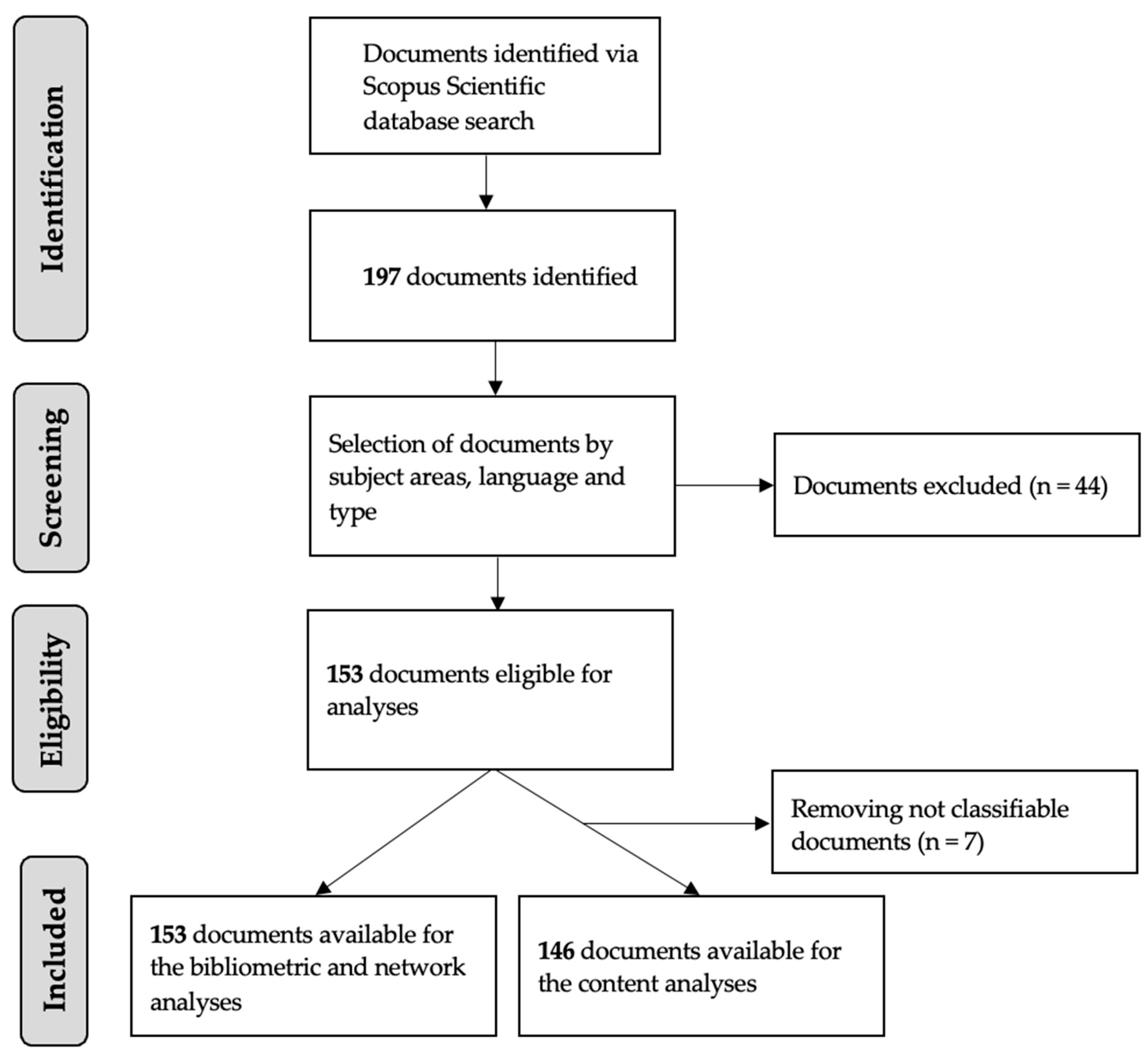
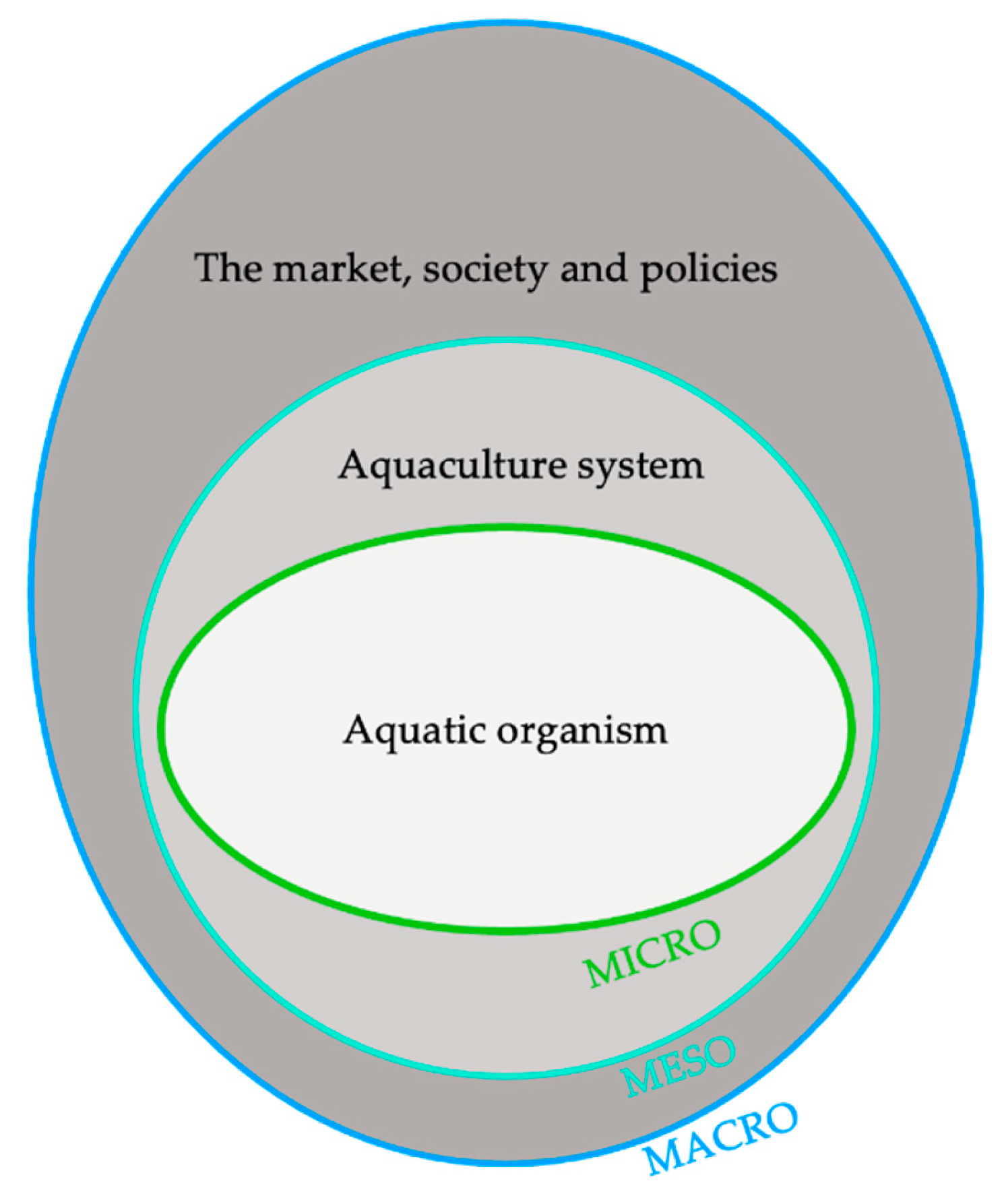
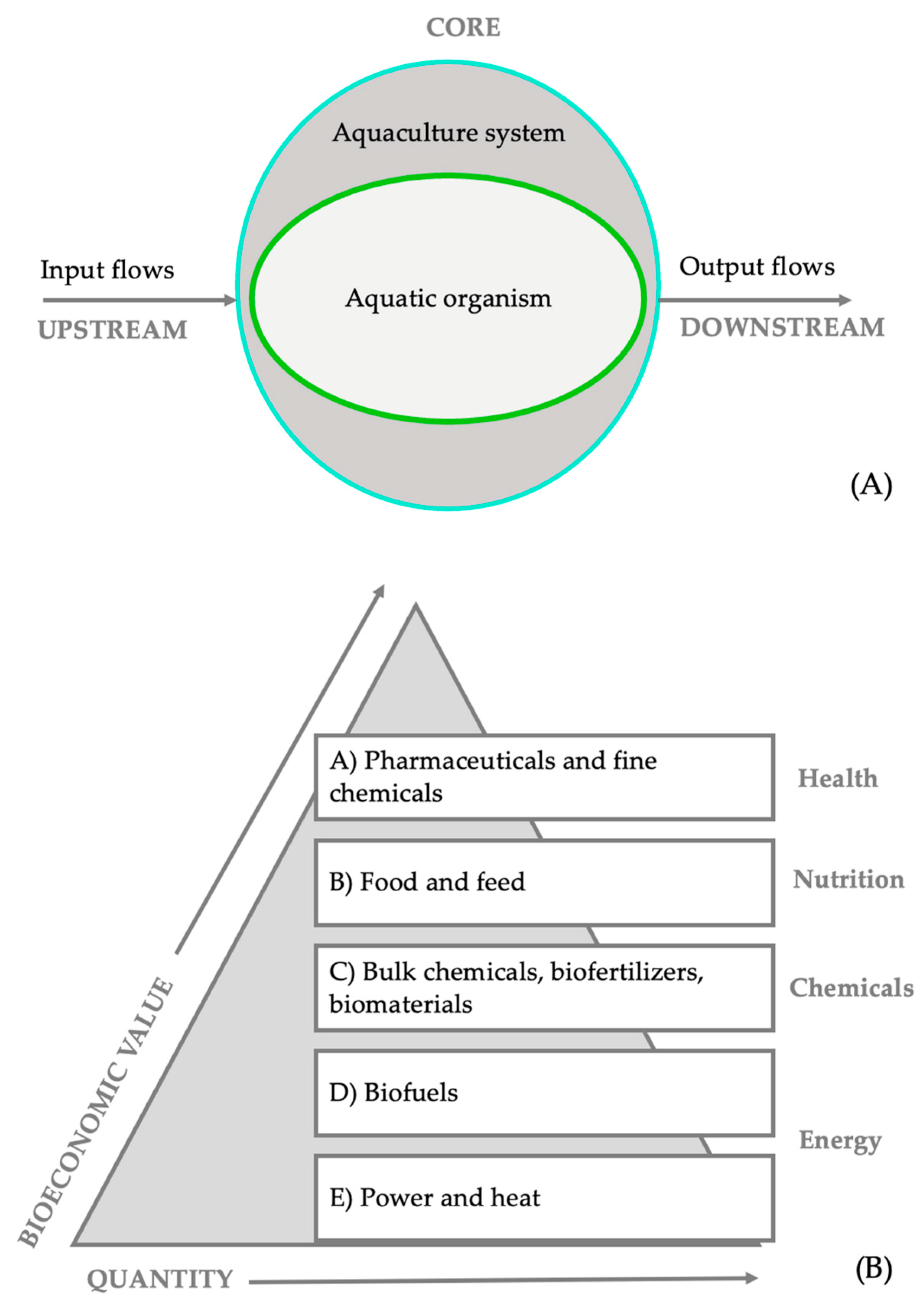
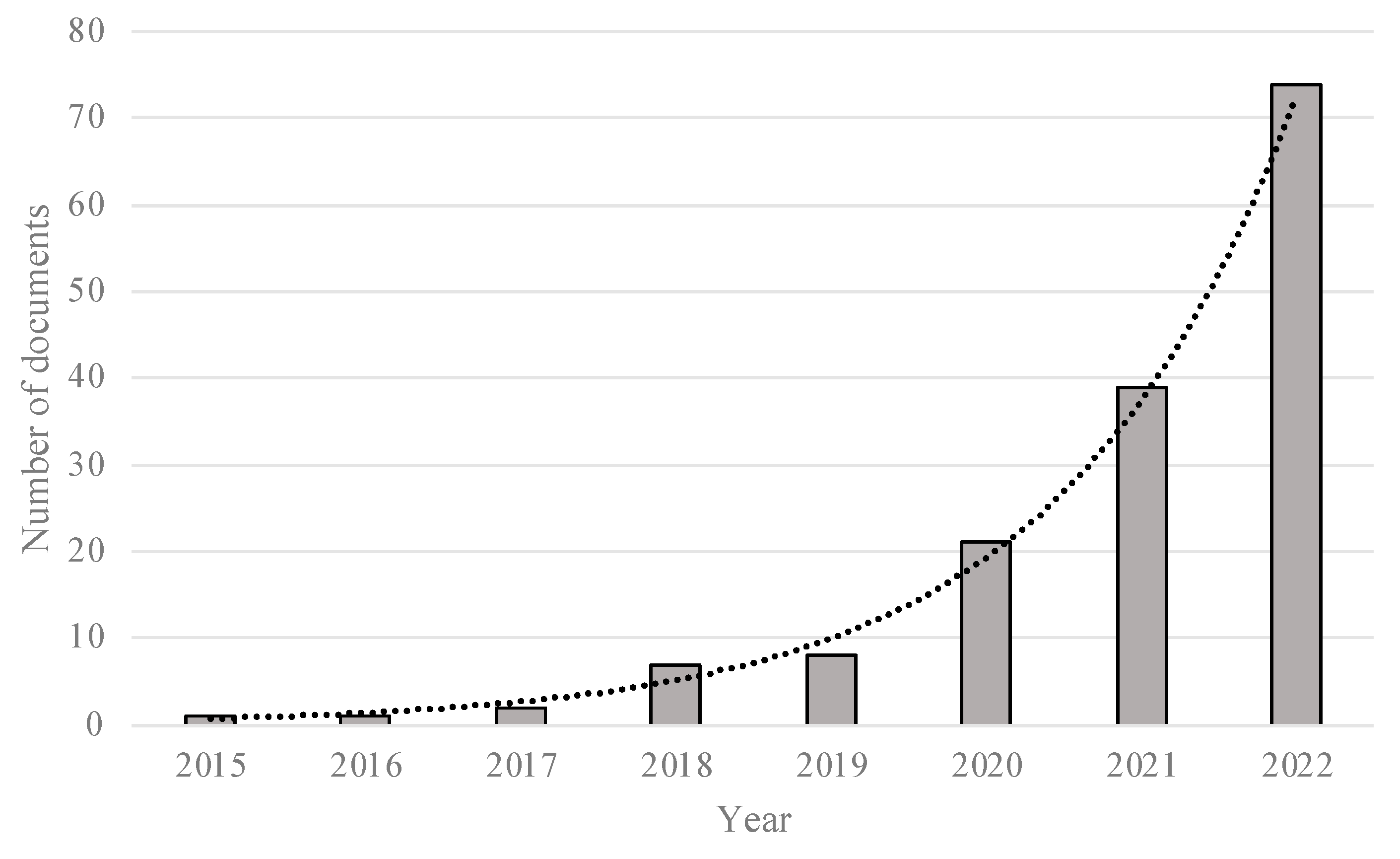

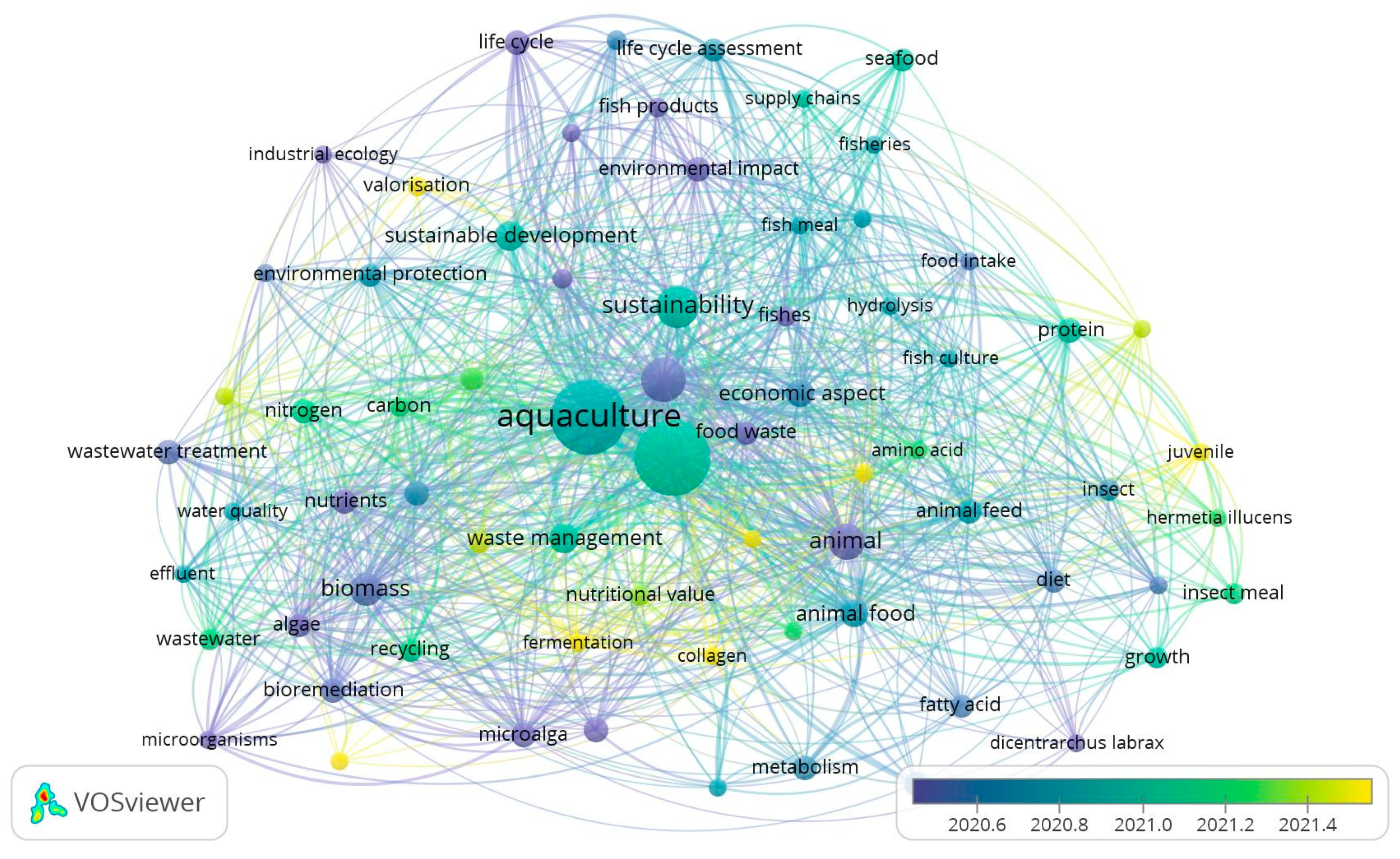


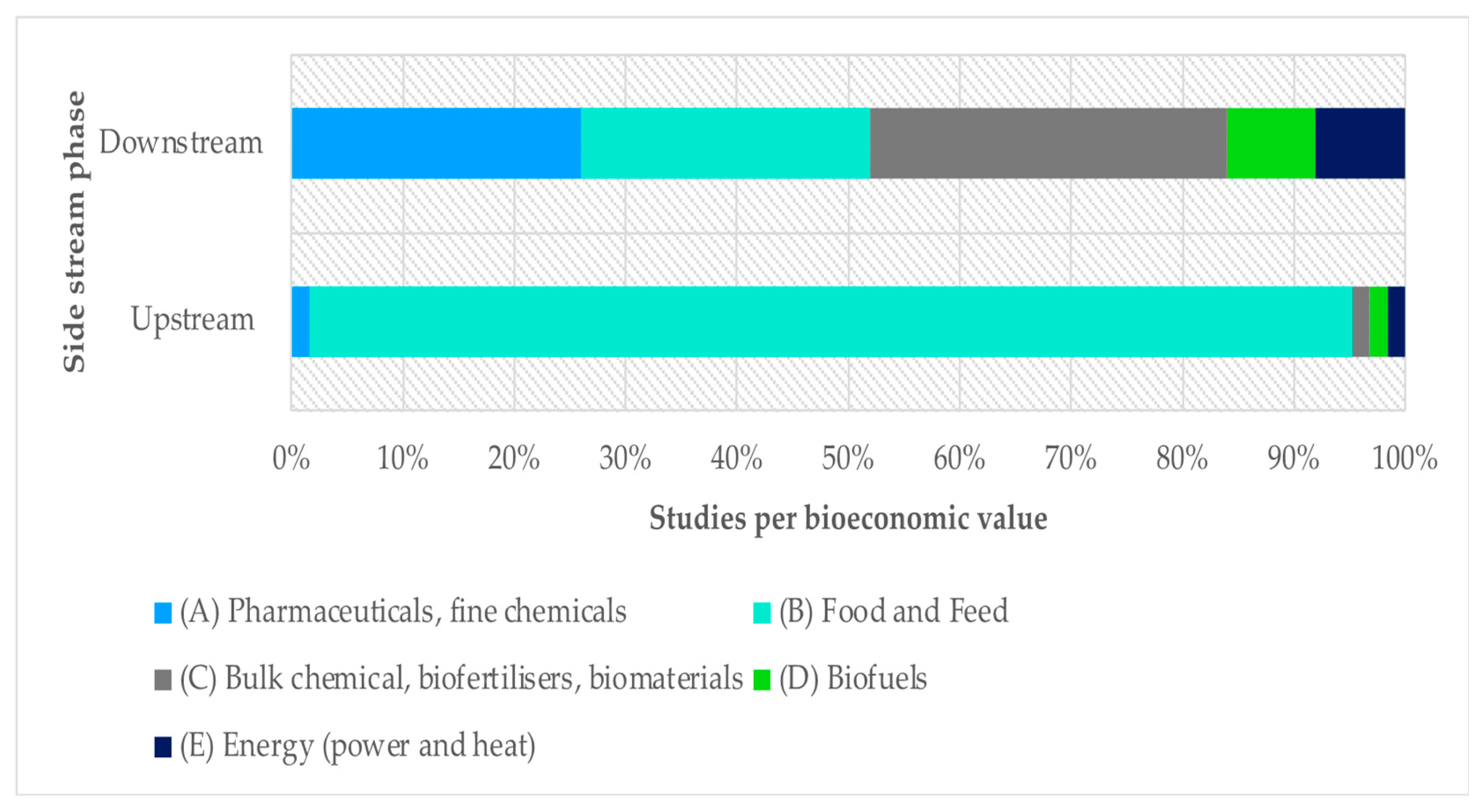
| Search query | TITLE-ABS-KEY (circular AND economy AND aquaculture) AND (LIMIT-TO (SUBJAREA, “ENVI”) OR LIMIT-TO (SUBJAREA, “AGRI”) OR LIMIT-TO (SUBJAREA, “ENGI”) OR LIMIT-TO (SUBJAREA, “SOCI”) OR LIMIT-TO (SUBJAREA, “BIOC”) OR LIMIT-TO (SUBJAREA, “EART”) OR LIMIT-TO (SUBJAREA, “BUSI”) OR LIMIT-TO (SUBJAREA, “ECON”)) AND (EXCLUDE (DOCTYPE, “ch”) OR EXCLUDE (DOCTYPE, “bk”)) AND LIMIT-TO (LANGUAGE, “English”) |
| Subject areas | “Environmental Science”, “Agricultural and Biological Sciences, Engineering”, “Social Sciences”, “Biochemistry, Genetics and Molecular Biology”, “Earth and Planetary Sciences”, “Business, Management and Accounting”, “Economics, Econometrics and Finance” |
| Publication type | Journal articles, reviews and conference papers |
| Database | Scopus |
| Period | 1 January 2007–31 December 2022 |
| Elements | |
|---|---|
| Documents | 153 |
| Sources (Journals) | 79 |
| Keywords Plus (ID) | 1465 |
| Authors’ Keywords (DE) | 574 |
| Years | 8 |
| Average Citations per Document | 10.25 |
| Author | 869 |
| Documents per Author | 0.176 |
| Authors per Document Author Appearances Co-Authors per Doc | 5.67 1021 6.67 |
| International Co-Authorship | 36.6% |
| Annual Percentual Growth Rate | 84.94 |
| Journals | Publisher | Number of Papers | Citations | Best Quartile | Impact Factor |
|---|---|---|---|---|---|
| Aquaculture | Elsevier | 11 | 150 | Q1 | 5.135 |
| Journal of Cleaner Production | Elsevier | 8 | 70 | Q1 | 11.072 |
| Sustainability (Switzerland) | MDPI | 7 | 64 | Q1 | 3.889 |
| Foods | MDPI | 6 | 38 | Q1 | 5.561 |
| Marine Drugs | MDPI | 6 | 103 | Q1 | 6.085 |
| Science of the Total Environment | Elsevier | 5 | 54 | Q1 | 10.754 |
| Frontiers in Marine Science | Frontiers | 4 | 6 | Q1 | 5.247 |
| Aquaculture International | Springer | 4 | 80 | Q2 | 2.953 |
| Reviews in Aquaculture | Wiley | 4 | 90 | Q1 | 10.618 |
| Scientific Reports | Nature | 4 | 78 | Q1 | 4.997 |
| Author | Affiliation | Number of Papers | H-Index | i-10 Index |
|---|---|---|---|---|
| Olivotto I. | Polytechnic University of Marche—Italy | 5 | 37 | 71 |
| Zarantoniello M. | Polytechnic University of Marche—Italy | 5 | 14 | 16 |
| Aldaco R. | University of Cantabria—Spain | 4 | 29 | 71 |
| Giorgini E. | Polytechnic University of Marche—Italy | 4 | 26 | 69 |
| Johansen J. | Norwegian Institute of Bioeconomy Research—Norway | 4 | 12 | 7 |
| Country | Number of Documents | Total Citations | Average Document Citation | Single-Country Publications (SCP) | Multi-Country Publications (MCP) | MCP Ratio |
|---|---|---|---|---|---|---|
| Italy | 29 | 443 | 15.28 | 24 | 5 | 17% |
| Spain | 18 | 176 | 9.78 | 8 | 10 | 55% |
| Portugal | 15 | 152 | 10.13 | 8 | 7 | 47% |
| United Kingdom | 9 | 161 | 17.89 | 5 | 4 | 44% |
| China | 8 | 69 | 8.62 | 6 | 2 | 25% |
| Keywords-Plus (ID) | No. Occurrences/Frequency |
|---|---|
| Aquaculture | 77 |
| Circular economy | 61 |
| Fish | 30 |
| Animal | 21 |
| Sustainability | 20 |
| Biomass | 15 |
| Sustainable development | 14 |
| Animal food | 12 |
| Economic aspect | 12 |
| Waste management | 12 |
Disclaimer/Publisher’s Note: The statements, opinions and data contained in all publications are solely those of the individual author(s) and contributor(s) and not of MDPI and/or the editor(s). MDPI and/or the editor(s) disclaim responsibility for any injury to people or property resulting from any ideas, methods, instructions or products referred to in the content. |
© 2024 by the authors. Licensee MDPI, Basel, Switzerland. This article is an open access article distributed under the terms and conditions of the Creative Commons Attribution (CC BY) license (https://creativecommons.org/licenses/by/4.0/).
Share and Cite
Masi, M.; Adinolfi, F.; Vecchio, Y.; Agnusdei, G.P.; Coluccia, B. Toward the Circular Economy in the Aquaculture Sector: Bibliometric, Network and Content Analyses. Sustainability 2024, 16, 5405. https://doi.org/10.3390/su16135405
Masi M, Adinolfi F, Vecchio Y, Agnusdei GP, Coluccia B. Toward the Circular Economy in the Aquaculture Sector: Bibliometric, Network and Content Analyses. Sustainability. 2024; 16(13):5405. https://doi.org/10.3390/su16135405
Chicago/Turabian StyleMasi, Margherita, Felice Adinolfi, Yari Vecchio, Giulio Paolo Agnusdei, and Benedetta Coluccia. 2024. "Toward the Circular Economy in the Aquaculture Sector: Bibliometric, Network and Content Analyses" Sustainability 16, no. 13: 5405. https://doi.org/10.3390/su16135405






